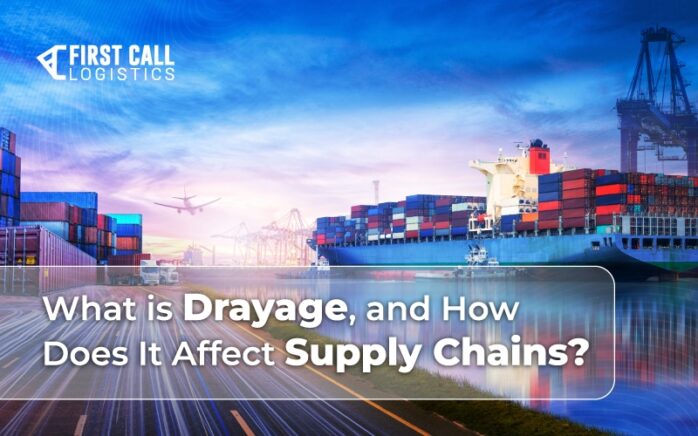What is Drayage, and How Does It Affect Supply Chains?

Many consumers picture shipping as a matter of moving products from A to B in one smooth, single-stepped journey – how else could something go from a warehouse to our doorstep in 48 hours? In truth, freight often moves from manufacturer to consumer in a less-than-linear fashion. While some phases of this transportation process may span vast distances, one of the most critical components of fast shipping times occurs just a few miles at a time.
Let’s talk drayage.
What is Drayage?
Drayage is the transportation of goods over short distances. You might hear it referred to as the “first mile” of transportation. There are at least a half-dozen different types of drayage (depending on who you ask), but each is used to link rail, sea and road transport together – all while keeping cargo safe and secure.
Drayage can refer to the short-distance hauls between a loading dock to a warehouse, or from a rail car to the trucking hub. These trips are almost always completed by truck, and one driver might complete multiple drayage trips in a single shift (a back-and-forth type of trip).
In shipping, the term drayage is also used when referring to the fees associated with this short-distance transportation. For the purpose of this discussion, the term drayage will strictly be used to indicate the mode of transportation.
Drayage Characteristics
As mentioned, drayage is the transportation of goods over short distances. A few characteristics to keep in mind are:
- The trip can be made in one shift.
- The departure and arrival points are within the same urban area.
- Drayage only uses one transportation method. For example, when the shipment is transferred from a truck and placed on a ship.
There are also different types of drayage:
- Door-to-door. Transportation of product from one location directly to the receiver (the business or home).
- Expedited. When goods need to be received in a timely manner or the need is urgent.
- Inter-carrier. Transportation of cargo between carriers, such as when a product is moved from a trucking terminal to a railway station.
- Intra-carrier. Transportation between different locations that are owned by the same company.
- Pier. Moving products from one location to a pier where there is a ship waiting for the next leg of the journey.
- Shuttle. When a particular facility is full, some goods are transported elsewhere for temporary storage. This includes both loaded and empty containers.
What Makes Drayage So Important?
Often drayage can be the difference between smooth sailing and damaging supply chain stalls. As more businesses collaborate for cost-effective logistical operations, more focus is being placed on drayage. Drayage services are set to grow by $2.9 billion between 2021 and 2025, as carriers and businesses alike aim to reduce supply chain disruptions. If freight can travel short distances efficiently and safely, the likelihood of delay for long hauls is reduced significantly.
Reducing Drayage Costs
Between June 2021 and June 2022, drayage costs rose by an average of 28%. Most of that spike owes itself to the COVID-19 pandemic, but some of these elevated fees aren’t going away anytime soon. Drayage rates are a combination of several factors:
- A base fee
- Distance to be traveled
- Total weight of the shipment
- Type of packaging
- Handling required
- Accessorial fees (such as driver detention, tolls, and equipment costs)
With this in mind, here are ways to reduce the cost of drayage:
- Packaging. Floor-loaded crates are usually the most cost efficient, pallets are a bit more expensive, and any fragile items or freight that necessitate special handling cost the most.
- Number of shipments. Rates are based on the hundredweight (CWT) of the shipment, which means that combining several pieces into one will lower the overall CWT. Some carriers might have a 200-pound (or 2 CWT) minimum per shipment. Consolidating your freight will help reduce these fees.
- Flexibility. If you can be flexible with pick-up and drop-off dates, your carrier can help you determine the best days to service your shipment. They’ll know port volume and equipment availability, which will help eliminate or reduce driver wait times and additional fees.
- Ship like things together. While we encourage consolidation, sometimes it makes more sense to ship things separately. For example, if you have a mixed load of crated freight and some pieces that require special handling, shipping them separately will reduce the overall cost of shipment.
- Documentation. Take photos and document all of your shipments. Having physical evidence can help you defend against any charges that don’t make sense.
- Hire a 3PL partner. Choosing a third-party logistics partner can help you reduce drayage costs. With their expertise, they can assist in packaging, shipment numbers, flexibility, and documentation.
If your aim is to reduce drayage costs and alleviate the stress of fulfillment services, First Call Logistics can help. Contact us today and learn how we can save your team time and money every step of the way.
Simplify your Next Shipment with First Call Logistics
Building and managing cost-efficient supply chains is a full-time job. First Call’s rare combination of in-house assets, expert problem-solving and track record of stellar customer service makes us the 3PL of choice for business partners with a wide range of shipping needs.
More Resources for FCL Shippers:
- Article: Understanding Intermodal Shipping: Five Common Questions
- Article: Three Keys to Managing High-Value Transport
- Article: Safeguarding Your Business Against Logistics Fraud
- Article: How to Protect Your Supply Chain from Cargo Theft
- Article: Benefits of Dedicated Transportation Strategies
- Article: How Partnering With a 3PL Strengthens Your Supply Chain
- Article: Achieving Supply Chain Visibility with a TMS
- Article: How to Become a Shipper of Choice
Get the latest supply chain news and updates directly to your inbox.